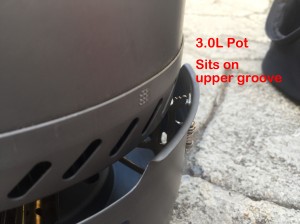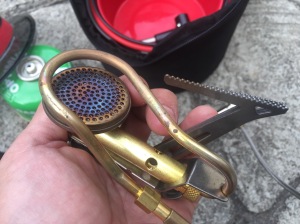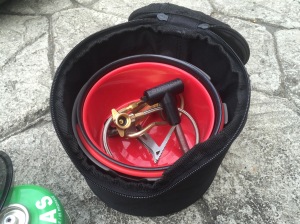Base stats:
– BTU: 7K (LPG)
– Weight: 21 oz (1.4 lbs)
– Stove comparison chart
The Primus ETA Spider is a wonderfully over-engineered hybrid of multiple Primus technologies all rolled into one.
It has the stand alone stove flexibility of a backpacking liquid fuel stove, it has the wind-screen protection of the ETA Power EF/MF series, and uses the incredibly versatile lindal valve fuel line and highly reliable ergopump.

The real magic of the ETA Power EF and this stove, the ETA Spider, is simmer control, and low heat efficiency. With most other stoves, high heat output efficiency is the goal, so they are highly efficient at boiling water fast. But with the ETA stoves, you can throttle heat back to a fairly low level, which allows slower cooking, or boiling water with less fuel. Everything about the ETA series is focused on extending the life of fuel, and the difference is significant.

Just one example: Both the ETA Power EF and the ETA Spider come with a thermal insulated bag or cozy, which further improves efficiency. When cooking stews, pastas in thick sauces, curry, and the like, you can cook the food to 80-90% and then turn the stove off, place the pot in the cozy, and let it finish cooking.
All three stoves in the ETA line have very special features that combine efficiency and flexibility, but of the three, the ETA Spider wins the prize in flexibility.
—–
A quick word about the other ETA stoves:
With a 1.8L pot and grooves designed for the 3L pot, the ETA Power EF is the big daddy of the family, and while its efficiency can’t be denied, the stove is a part of the wind screen and can’t be used independantly of it. The wind screen contains the pot stand as well, further limiting flexibility. This limits the stove’s usability, as using frying pans or additional sauce pans becomes a bit of a challenge.
For more information on the ETA Power EF: https://somecampingstoves.wordpress.com/2014/12/06/primus-eta-power-ef-stove/
The ETA Lite, while containing several well engineered components and a unique triangular locking mechanism, has the same limitations of most stoves that are lock-stacked above the gas canister.
—-
Unlike the ETA Power EF and the ETA Lite, the ETA Spider, the newest addition to the ETA family, adds a high level of flexibility.
Really, the core stove portion looks similar to many portable stoves today in that there are three legs which are all folded together and also doubles as the pot stand, and then there is a fuel line to connect to a fuel source (gas canister or liquid fuel bottle). This is very similar to other LPG and liquid fuel stoves that have a flexible fuel line system, which means that the stove can be used without the windscreen, and with just about any pot, pan, or cup.
The windscreen has three magnets at the base that align with the stove legs to keep the stove stable, almost as stable as the ETA Power EF.
The pot stand portion of the legs come just a hair above the rim of the windscreen, so you can really use any pot/pan/cup you like on the stove, even with the windscreen. And therein lies the key differentiator between the ETA Spider and the ETA Power EF. With the ETA Power EF, you can use other pots, but it is cumbersome because the pot holder pieces are recessed under the rim of the of the windscreen, and you can’t use the stove without the windscreen. The ETA Spider gets rid of that problem.
—
Moving on to the the pot (or sauce pan, if you will):
The pot has fold out handles that hug the pot when folded in, and this then fits in the windscreen. It’s a tight fit, but fits just fine.
The pot itself has a non-stick coating, and while this is much thicker than most non-stick coatings I’ve seen on backpacking gear, it’s no where near the thickness in coating of a kitchen pan, so burn in will eventually occur. Still, the coating is noticeably thicker than than the non-stick coatings on most backpacking sets I own, so with care, burn-in could be delayed for a pretty long time.
Thanks to the heat exchanger, the ETA series of stoves are very heat efficient, so keep the heat output low, to extend the life of the non-stick coating.
The ETA Spider also comes with a food bowl (Just like the ETA Power EF). I typically use that during food prep, as I like to pre-cook some ingredients before throwing everything together into whatever stew-like or pasta’ish or curry’like concoction being prepared, but if you have the efficiency to prepare everything in the pot and cook in phases, it’d still be fine being used for it’s intended purpose, a food bowl.
In a simple test, I boiled a little over half a liter in 2:40. Really it was boiling at about 2:20, But I don’t count water as boiling until the water is at its most aggressive rolling boil.
Of course, the great thing about this set is that you can purchase, separately, the multi-fuel kit, which allows you to use white gas, kerosene, and other similar fuels (No alcohol though). This is particularly useful if you’re not sure what fuel you’ll have and want some flexibility, or if you are trying to avoid the trash buildup of empty gas canisters, or if you are planning on cookng in particularly cold weather and want a more stable and consistent fuel in dramatically changing temperature conditions.
A small tip: Primus sells several multi-fuel kits, for the older Gravity stove, the ETA Power EF/MF/SPider, but the kits are all essentially identical, only very different prices. The ETA Spider multi-fuel kit sells for over $100, the Gravity multi-fuel kit sells for $55. They’re all the same. The ETA Power EF kit sells for $75, I think. There is one small differece. The spider multifuel kit comes with a separate plate. The ETA Power EF has the heating plate built into the stove, but the ETA Spider doesn’t. The heating plate is where you put a little of the fuel to pre-heat the copper rigid fuel ingress point. This heats the fuel enough to catch and at least get flame out of the stove, and that flame coming out of the stove then heats the generator, making the fuel vaporize more efficiently. But, i just fashion a small bowl out of aluminum foil.
Interestingly, Primus now also sells the ETA Spider without the wind screen and pot, so you can just get the stove portion. I’m not sure why anyone would do this because the stove has one small flaw, well, not a flaw so much as a slightly fragile design:
Many liquid fuel capable stoves on the market today and many older backpacking stoves all need some way to pre-heat the fuel to vaporize it. In days past, it was done through something called a “generator” or “heat coil” or “heating element”. All this really means is that the fuel line didn’t go directly into the stove. Rather, the fuel line connects to a brass tube that goes around the top of the stove to be pre-heated and vaporized before coming back around to send fuel into the stove fuel injection point.
This is particularly true of Kerosene/diesel/parafin as the vaporization temperature is very high (which is also what makes it such a safe fuel), but applies to white gas and petrol as well (which has a lower flash point, and is therefore less safe, but also easier to deal with). This is true of gas cansiter stoves including butane stoves as well, it’s just less noticeable because the temperature where it needs pre-heating is so low, that under most 3 season camping conditions, it doesn’t need pre-heating.


Notice the ETA Spider (left), has no protective brackets for the generator. The Snow Peak Geoshield (right) has steel reinforcement brackets to mitigate potential damage to the generator.
That generator typically is made of brass because brass isn’t as affected by heat as other metals. However, while brass is very strong in resistance to temperature, it’s very weak as a structural metal. Brass is soft. And unfortunately, since it needs to be above the flame, it needs to be completely exposed….soft metal…completely exposed…equals fragile.
What’s more, on the Primus ETA Spider’s generator (and therefore, on the Spider Express), the generator is very large, and surprisingly, that generator is not reinforced with steel brakcets like it is on other generator based liquid fuel stoves.
It was a genius design back in the day (though generators were always on any purchasable spare parts list), but if you look at the Primus Omnifuel/Omnilite, Optimus Nova+/Polaris Optifuel (I own and use all of these marvels), you’ll see that the best engineering today gets rid of this weak link in backpacking stoves, instead building the pre-heating element into a short, hardened straight line tube and the base of the fire shield (a.k.a fire ring, soot trap), which draws heat not from the stove fire, but from the entire copper assembly, including the soot trap. Which is why it’s interesting that the ETA series, the pinnacle of Primus stove engineering, uses this older generator coil technology.
Except for that one issue, which is less worrying since the stove assembly is always stored in the ETA Spider pot itself, the Primus ETA Spider is among the best stove setups I own.
—
In use and container size, the ETA Spider competes most closely with the JetBoil MiniMo.
I prefer the ETA Spider, mostly because the MiniMo is a lock-stack LPG only stove, which limits uses somewhat. In extremely cold weather, upright LPG canisters won’t use all the fuel, because a portion of the fuel won’t vaporize. Flipping an LPG canister would help use up all the fuel, but you can’t flip the LPG can with the MiniMo. the ETA Spider also allows use of liquid fuels, the MiniMo doesn’t. And the Spider also comes with the extra plastic bowl.
But both are great simmering, both are great at doing some real cooking, and both are extremely efficient with fuel, allowing fuel to last an inordinately long time.
I’ve made fried spaghetti, curry, chili, frank and beans, stews of all kinds, fried eggs and bacon, made hash browns, cooked up Italian sausages, pretty much everything you can do with a sauce pan or fry pan over a heat source, you can do with the ETA Spider. The one thing it can’t really do is bake because there’s no real way to get heat from the top. Otherwise, it’s a pretty versatile and fool proof reliable piece of kit.
BTW, I often leave the cozy at home. While it is does add to fuel efficiency if used correctly, it does add significant bulk and weight and makes fitting in a backpack a little more difficult. A few fat rubber bands is all that’s used to keep everything held together.
—-
ADDENDUM 1: What ETA pots fit?
Dan asked in the comments section if the 1.8L and 3L ETA pots fit. Great question. The 1.8L fits not without a problem. The 3L fits, but you have to be careful because the heat exchanger is narrow.
Below: The ETA pot that comes with the Spider

Below: The 1.8L ETA pot

Below the 3L Pot


As you can see from above, the 3L fits without any problem, but there is some small risk.
Below: On the off chance you decide to use the 3L pot on the without the Spider wind shield, here is a photo of how the 3L pot would fit. As you can see the 3L fits, but just barely. Pretty risky setup. Even a hard rolling boil of water could vibrate the pot enough to have it tip over.

—-
More reviews from around the web:
- http://theessentialcyclist.com/773/review-primus-eta-spider
- http://www.gearinstitute.com/hiking/item/primus-eta-spider
- http://www.rokslide.com/forums/showthread.php?17047-Testing-a-lot-of-backpacking-stoves
- http://thisisrange.com/radical-by-design-primus-eta-spider/
- http://www.ultralightoutdoorgear.co.uk/downloads/1414511394PrimusEtaSpider_Trek&MountainOCT14.jpg
Some youtube videos:



















Pingback: Primus Eta Power EF Stove Review | Camping Stoves and Other Gear Reviews
I have a question: Can the ETA Spider windshield and stove take the new ETA 1.8L or 3.0L pots?
LikeLiked by 1 person
Hi Dan, sorry to take so long to get back to you. The 1.8L fits no problem. The 3L can fit, but you’d have to be a little careful because the heat exchanger width is a tad narrow. I am adding an addendum so you can see the three pots and how they fit on the Spider.
LikeLike
Hi Tekkster,
I was wondering whether you can adjust the flame when the express spider stove is rigged up into liquid fuel mode. It is unclear from the Primus website whether the multifuel kit makes it possible for the express spider stove to vary the flame control when running liquid fuel. I’m sorry if it obvious from the above article but I’m still a little confused. Product development at Primus is going through a real high point at the moment; ETA pots are the best I’ve used, regardless of what stove they are used with. Great reviews BTW.
cheers
Rufus
LikeLiked by 1 person
Hi Rufus, Thanks for the question.
The flame is adjustable. It’s about as fine tunable as the MSR WhisperLite or Edelrid Hexon, but not quite as fine tuned as the Primus OptiFuel or OmniLite.
Probably the most common competitor to the ETA Spider is the JetBoil MiniMo.
Comparing those two, I’d say:
– MiniMo can’t do liquid fuel, Spider can do both
– MiniMo has better fine tune control
– Spider’s separated fuel line has more flexibility with LPG
– Spider’s stove stand is more stable
– Spider’s pot is wider, but lower.
– Spider’s stove means flexible with pots.
A bit of a long winded answer, hope this helps.
LikeLike
Thanks – much appreciated. I have an express spider which is a brilliant stove which I currently use with an MSR foil windscreen/base, and a 1.8L ETA Pot. I own many stoves including ones made by MSR and Primus – far too many! However, I think I will investigate a multifuel kit for the Express spider stove because it is very lightweight and very reliable in its LPG form. The fact that you can invert the LPG canister and the stove has a generator coil really helps in cold conditions when I have used it for climbing. Keep up the good work
LikeLiked by 1 person
As an addendum: the ETA Pots have a new ceramic non-stick coating as opposed to the usual PTFE coating, which is supposed to be far more durable and addresses the perceived health risks associated with the older PTFE coatings.
Rufus
LikeLiked by 1 person
Yeah. I heard the same thing. So I have the new ETA pots. But I still get a center circle burn in on the pot.
LikeLike
“Time will tell, I suppose’ if these new coatings are an improvement on the old ones
LikeLiked by 1 person
Thanks for great reviews and for stove comparison chart!
In your opinion, are these stoves the same efficient in cold winter conditions with the wind – ETA Spider or ETA Power EF? Unlike Spider, the windscreen of ETA Power covers the pots on the bottom, but does it matters a lot?
You told the 3.0L pot works well despite of the higher pisition compare to 1.8L, but did you see any noticeable difference?
BTW, did you test PrimeTech stoves?
LikeLiked by 1 person
The ETA Spider and ETA Power EF are both excellent stoves in winter conditions. In breezy conditions, I would give an extra nod to the ETA Power EF, though not by much as the ETA Spider works fairly well. The wide base really makes both ideal for use in the cold, and by placing either stove on a shovel, you can minimize sinking in the snow during use.
I’m not sure you can still get the ETA Power EF as Primus has upgraded the stove. I haven’t purchased or tested the newer version (Primetech stoves), but I plan to!
LikeLiked by 1 person